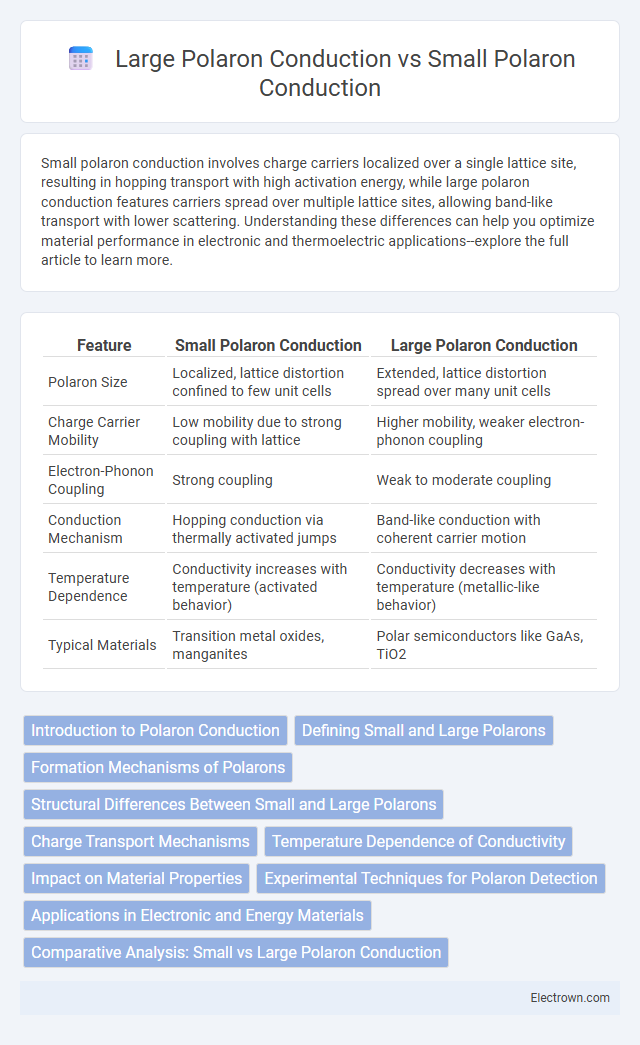Small polaron conduction involves charge carriers localized over a single lattice site, resulting in hopping transport with high activation energy, while large polaron conduction features carriers spread over multiple lattice sites, allowing band-like transport with lower scattering. Understanding these differences can help you optimize material performance in electronic and thermoelectric applications--explore the full article to learn more.
Table of Comparison
| Feature | Small Polaron Conduction | Large Polaron Conduction |
|---|---|---|
| Polaron Size | Localized, lattice distortion confined to few unit cells | Extended, lattice distortion spread over many unit cells |
| Charge Carrier Mobility | Low mobility due to strong coupling with lattice | Higher mobility, weaker electron-phonon coupling |
| Electron-Phonon Coupling | Strong coupling | Weak to moderate coupling |
| Conduction Mechanism | Hopping conduction via thermally activated jumps | Band-like conduction with coherent carrier motion |
| Temperature Dependence | Conductivity increases with temperature (activated behavior) | Conductivity decreases with temperature (metallic-like behavior) |
| Typical Materials | Transition metal oxides, manganites | Polar semiconductors like GaAs, TiO2 |
Introduction to Polaron Conduction
Polaron conduction occurs when charge carriers, such as electrons or holes, couple with lattice vibrations, forming quasiparticles known as polarons. Small polaron conduction involves strong electron-phonon interaction, leading to localized carriers hopping between lattice sites, resulting in thermally activated transport. Large polaron conduction features weaker coupling, allowing carriers to delocalize over multiple lattice sites, enabling band-like conduction with lower effective mass and higher mobility.
Defining Small and Large Polarons
Small polarons form when charge carriers interact strongly with the lattice, causing localized distortions confined to a single or few atoms, leading to hopping conduction. Large polarons occur when charge carriers couple more weakly with the lattice, resulting in a widespread distortion over many lattice sites and enabling band-like conduction. Your understanding of small versus large polaron conduction hinges on the spatial extent of these lattice distortions and the strength of electron-phonon interactions.
Formation Mechanisms of Polarons
Small polaron conduction occurs when charge carriers strongly interact with the lattice, causing localized lattice distortions that trap the carrier and lead to hopping-based transport. Large polaron conduction involves weaker electron-phonon coupling, allowing the carrier to remain delocalized over multiple lattice sites with a larger lattice distortion spread. Understanding these formation mechanisms is essential for optimizing your material's electronic and optical properties in applications such as semiconductors and energy devices.
Structural Differences Between Small and Large Polarons
Small polarons involve localized charge carriers trapped by strong electron-lattice interactions, causing significant lattice distortion at the atomic scale. Large polarons extend over several lattice sites with weaker coupling, resulting in more diffuse lattice deformation and lower effective mass. These structural differences influence their mobility, with small polarons exhibiting hopping conduction and large polarons demonstrating band-like conduction.
Charge Transport Mechanisms
Charge transport in small polaron conduction occurs through localized hopping between lattice sites, resulting in thermally activated mobility and strong electron-phonon interactions that localize carriers. Large polaron conduction involves delocalized charge carriers coupled weakly to lattice vibrations, allowing band-like transport with higher mobility and less temperature dependence. The distinct electron-phonon coupling strengths and carrier localization define the difference in charge transport mechanisms between small and large polaron conduction.
Temperature Dependence of Conductivity
Small polaron conduction exhibits a strong temperature dependence with conductivity typically increasing exponentially as temperature rises, due to thermally activated hopping mechanisms. Large polaron conduction shows weaker temperature dependence because charge carriers move more freely through the lattice with reduced scattering. In materials like transition metal oxides, small polaron hopping dominates at higher temperatures, while large polaron conduction is prominent at lower temperatures or in systems with strong electron-phonon coupling and low localization.
Impact on Material Properties
Small polaron conduction typically leads to lower electrical conductivity and higher activation energy due to strong electron-phonon interactions, causing localized charge carriers that limit mobility. Large polaron conduction, with weaker interactions and more delocalized carriers, enhances conductivity and reduces scattering effects, positively impacting a material's electronic and optical properties. Understanding these conduction mechanisms helps optimize your material's performance for applications in electronics and energy devices.
Experimental Techniques for Polaron Detection
Experimental techniques for distinguishing small polaron conduction from large polaron conduction primarily include temperature-dependent resistivity measurements and infrared absorption spectroscopy. Small polarons typically exhibit thermally activated hopping behavior, observable through Arrhenius-type temperature dependence in electrical conductivity, while large polarons show more delocalized conduction features with distinct vibrational modes in infrared spectra. You can leverage these methods to accurately identify polaron type and better understand charge transport mechanisms in complex oxides and semiconductor materials.
Applications in Electronic and Energy Materials
Small polaron conduction dominates in transition metal oxides, enabling high-temperature thermoelectric devices due to localized charge carriers that enhance Seebeck coefficients. Large polaron conduction occurs in polar semiconductors like perovskites, facilitating high mobility and efficient charge transport critical for solar cells and optoelectronic devices. Understanding the balance between small and large polaron effects optimizes material selection for energy storage, sensors, and electronic applications.
Comparative Analysis: Small vs Large Polaron Conduction
Small polaron conduction involves localized charge carriers causing significant lattice distortion and strong electron-phonon interaction, resulting in thermally activated hopping transport. Large polaron conduction features delocalized charge carriers with weaker electron-phonon coupling, allowing band-like mobility and less temperature dependence. Comparative analysis shows small polarons dominate in materials with strong ionic character and narrow bandwidth, while large polarons occur in semiconductors with moderate electron-phonon coupling and wider bands.
Small Polaron Conduction vs Large Polaron Conduction Infographic

 electrown.com
electrown.com